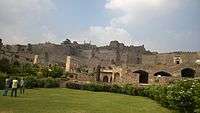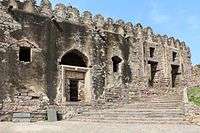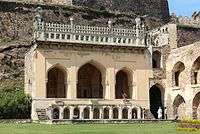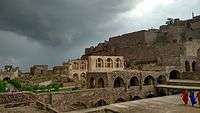Golkonda
| Golkonda | |
|---|---|
|
గోల్కొండ گولکنڈہ | |
 Golkonda Fort | |
 Location within Telangana | |
| General information | |
| Country | India |
| Coordinates | 17°23′N 78°24′E / 17.38°N 78.40°E |
| Completed | 1600s |
Golkonda, also known as Golconda, Gol konda ("Round shaped hill"), or Golla konda ("Shepherd's hill"), is a citadel and fort in Southern India and was the capital of the medieval sultanate of the Qutb Shahi dynasty (c.1518–1687), is situated 11 kilometres (6.8 mi) west of Hyderabad. It is also a tehsil of Hyderabad district, Telangana, India. The region is known for the mines that have produced some of the world's most famous gems, including the Koh-i-Noor, the Hope Diamond and the Nassak Diamond.
History
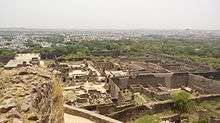
Golkonda Fort was first built by the Kakatiya dynasty as part of their western defenses along the lines of the Kondapalli Fort. The city and the fortress were built on a granite hill that is 120 meters (480 ft) high, surrounded by massive battlements. The fort was rebuilt and strengthened by Rani Rudrama Devi and her successor Prataparudra.[1][2] Later, the fort came under the control of the Musunuri Nayaks, who defeated the Tughlaqi army occupying Warangal.[3] It was ceded by the Musunuri Kapaya Nayak to the Bahmani Sultanate as part of a treaty in 1364.[4][5]
Under the Bahmani Sultanate, Golkonda slowly rose to prominence. Sultan Quli Qutb-ul-Mulk (r. 1487–1543), sent as a governor of Telangana, established it as the seat of his government around 1501. Bahmani rule gradually weakened during this period, and Sultan Quli formally became independent in 1538, establishing the Qutb Shahi dynasty based in Golkonda.[6][7] Over a period of 62 years, the mud fort was expanded by the first three Qutb Shahi sultans into the present structure, a massive fortification of granite extending around 5 km in circumference. It remained the capital of the Qutb Shahi dynasty until 1590 when the capital was shifted to Hyderabad. The Qutb Shahis expanded the fort, whose 7 kilometres (4.3 mi) outer wall enclosed the city.
The fort finally fell into ruin in 1687, after a year long siege leading to its fall at the hands of the Mughal emperor Aurangzeb.[8]
Diamonds

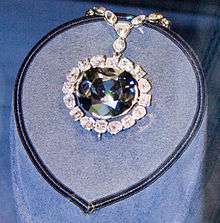

The Golkonda Fort used to have a vault where once the famous Koh-i-Noor and Hope diamonds were stored along with other diamonds.[9]
Golkonda is renowned for the diamonds found on the south-east at Kollur Mine near Kollur, Guntur district, Paritala and Atkur in Krishna district and cut in the city during the Kakatiya reign. At that time, India had the only known diamond mines in the world. Golkonda's mines yielded many diamonds. Golkonda was the market city of the diamond trade, and gems sold there came from a number of mines. The fortress-city within the walls was famous for diamond trade. However, Europeans believed that diamonds were found only in the fabled Golkonda mines. Magnificent diamonds were taken from the mines in the region surrounding Golkonda, including the Daria-i-Noor or "Sea of Light", at 185 carats (37.0 g), the largest and finest diamond of the crown jewels of Iran.
Its name has taken a generic meaning and has come to be associated with great wealth. Gemologists use this classification to denote a diamond with a complete (or almost-complete) lack of nitrogen; "Golconda" material is also referred to as "2A".
Many famed diamonds are believed to have been excavated from the mines of Golkonda, such as:
- Daria-i-Noor
- Noor-ul-Ain
- Koh-i-Noor
- Hope Diamond
- Princie Diamond
- Regent Diamond
- Wittelsbach-Graff Diamond
By the 1880s, "Golkonda" was being used generically by English speakers to refer to any particularly rich mine, and later to any source of great wealth.
During the Renaissance and the early modern eras, the name "Golkonda" acquired a legendary aura and became synonymous for vast wealth. The mines brought riches to the Qutb Shahis of Hyderabad State, who ruled Golkonda up to 1687, then to the Nizam of Hyderabad, who ruled after the independence from the Mughal Empire in 1724 until 1948, when the Indian integration of Hyderabad occurred.
The Fort
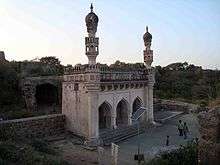
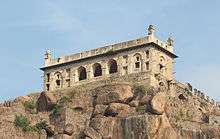
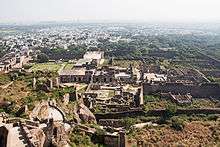

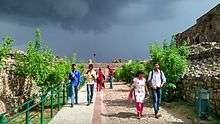

The Golkonda fort is listed as an archaeological treasure on the official "List of Monuments" prepared by the Archaeological Survey of India under The Ancient Monuments and Archaeological Sites and Remains Act.[10] Golkonda actually consists of four distinct forts with a 10 km long outer wall with 87 semicircular bastions (some still mounted with cannons), eight gateways, and four drawbridges, with a number of royal apartments and halls, temples, mosques, magazines, stables, etc. inside. The lowest of these is the outermost enclosure into which we enter by the "Fateh Darwaza" (Victory gate, so called after Aurangzeb’s triumphant army marched in through this gate) studded with giant iron spikes (to prevent elephants from battering them down) near the south-eastern corner. At Fateh Darwaza can be experienced a fantastic acoustic effect, characteristic of the engineering marvels at Golkonda. A hand clap at a certain point below the dome at the entrance reverberates and can be heard clearly at the 'Bala Hisar' pavilion, the highest point almost a kilometer away. This worked as a warning note to the royals in case of an attack.
The whole of the Golkonda Fort complex and its surrounding spreads across 11 km of total area, and discovering its every nook is an arduous task. A visit to the fort reveals the architectural beauty in many of the pavilions, gates, entrances and domes. Divided into four district forts, the architectural valour still gleams in each of the apartments, halls, temples, mosques, and even stables. The graceful gardens of the fort may have lost their fragrance, for which they were known 400 years ago, yet a walk in these former gardens should be in your schedule when exploring the past glories of Golkonda Fort.
Bala Hissar Gate is the main entrance to the fort located on the eastern side. It has a pointed arch bordered by rows of scroll work. The spandrels have yalis and decorated roundels. The area above the door has peacocks with ornate tails flanking an ornamental arched niche. The granite block lintel below has sculpted yalis flanking a disc. The design of peacocks and lions is a blend of Hindu – Muslim architecture.
Toli Masjid, situated at Karwan, about 2 km from the Golkonda fort, was built in 1671 by Mir Musa Khan Mahaldar, royal architect of Abdullah Qutb Shah. The facade consists of five arches, each with lotus medallions in the spandrels. The central arch is slightly wider and more ornate. The mosque inside is divided into two halls, a transverse outer hall and an inner hall entered through triple arches.
Much thought went into building this gate. A few feet in front of the gate is a large wall. This prevented elephants and soldiers (during enemy attacks) from having a proper ramp to run and break the gate.
The fort of Golkonda is known for its magical acoustic system. The highest point of the fort is the "Bala Hissar", which is located a kilometer away. The palaces, factories, water supply system and the famous "Rahban" cannon, within the fort are some of the major attractions.
It is believed that there is a secret underground tunnel that leads from the "Durbar Hall" and ends in one of the palaces at the foot of the hill. The fort also contains the tombs of the Qutub Shahi kings. These tombs have Islamic architecture and are located about 1 km north of the outer wall of Golkonda. They are encircled by beautiful gardens and numerous exquisitely carved stones. It is also believed that there was a secret tunnel to Charminar.
The two individual pavilions on the outer side of Golkonda are also major attractions of the fort. It is built on a point which is quite rocky. The "Kala Mandir" is also located in the fort. It can be seen from the king's durbar (king's court) which was on top of the Golkonda Fort.
The other buildings found inside the fort are :
- Habshi Kamans (Abyssian arches), Ashlah Khana, Taramati mosque, Ramadas Bandikhana, Camel stable, private chambers (kilwat), Mortuary bath, Nagina bagh, Ramasasa's kotha, Durbar hall, Ambar khana etc.
This majestic structure has beautiful palaces and an ingenious water supply system. Sadly, the unique architecture of the fort is now losing its charm.
The ventilation of the fort is absolutely fabulous having exotic designs. They were so intricately designed that cool breeze could reach the interiors of the fort, providing a respite from the heat of summer.
The Huge gates of the fort are decorated with large pointed iron spikes. These spikes prevented elephants from damaging the fort. The fort of Golkonda is encircled by an 11-km-long outer wall. This was built in order to fortify the fort.
Naya Qila (New Fort)
Naya Qila is an extension of Golkonda Fort. The ramparts of the new fort start after the residential area with many towers and the Hatiyan ka Jhad "Elephant-sized tree" - an ancient baobab tree with an enormous girth. It also includes a war mosque. The local government plans to convert the area into a golf club.
Qutub Shahi Tombs
The tombs of the Qutub Shahi sultans lie about one kilometer north of Golkonda's outer wall. These structures are made of beautifully carved stonework, and surrounded by landscaped gardens. They are open to public and receive many visitors.
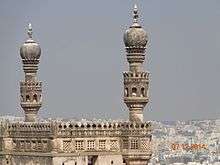
In popular culture
- Russell Conwell's book Acres of Diamonds tells a story of the discovery of the Golkonda mines.
- René Magritte's painting Golconda was named after the city.
- John Keats' early poem "On receiving a curious Shell" opens with the lines: "Hast thou from the caves of Golkonda, a gem / pure as the ice-drop that froze on the mountain?"[11]
- Referenced in the classical Russian ballet, La Bayadère
Other places with the same name
- A city in Illinois, United States is named after Golconda.
- A city in Nevada, United States is named after Golconda.
- A village located in the southern part of Trinidad was the name given in the 19th century to a rich tract of land which was once a sugar-cane estate. Currently, mostly descendants of East Indian indentured servants occupy the village of Golconda.
Gallery
| Golkonda Fort | ||||||||||||||||||||||||
|---|---|---|---|---|---|---|---|---|---|---|---|---|---|---|---|---|---|---|---|---|---|---|---|---|
|
See also
- Afanasiy Nikitin – the first European to visit Golkonda
- Telangana
- Charminar
- Asaf Jahi
- History of Hyderabad
- History of India
- Middle kingdoms of India
- Naya Qila
- Qutb Shahi dynasty
- Taramati Baradari
- Agra Fort
- Warangal Fort
- Bhongir Fort
References
- ↑ Sardar, Golconda through Time 2007, pp. 25-26.
- ↑ Saqi Mustaid Khan, Ma'asir-i-Alamgiri, Translated by Jadunath Sarkar, Royal Asiatic Society of Bengal, Calcutta; 1947, p. 183
- ↑ Sardar, Golconda through Time 2007, p. 44.
- ↑ Prasad, History of the Andhras 1988, p. 172.
- ↑ Sardar, Golconda through Time 2007, p. 20.
- ↑ Sardar, Golconda through Time 2007, pp. 66-67.
- ↑ Sen, Sailendra (2013). A Textbook of Medieval Indian History. Primus Books. p. 118. ISBN 978-9-38060-734-4.
- ↑ Gopal, Madan (1990). K.S. Gautam, ed. India through the ages. Publication Division, Ministry of Information and Broadcasting, Government of India. p. 178.
- ↑ Bradnock, Roma. Footprint India. p. 1035. ISBN 978-1-906098-05-6.
- ↑ "Alphabetical List of Monuments - Andhra Pradesh". Archaeological Survey of India. Archived from the original on 25 June 2014.
- ↑ "6. On receiving a curious Shell. Keats, John. 1884. The Poetical Works of John Keats". Bartleby.com. Retrieved 2013-05-01.
Bibliography
- Prasad, G. Durga (1988), History of the Andhras up to 1565 A. D. (PDF), Guntur: P. G. Publishers
- Sardar, Marika (2007), Golconda through Time: A Mirror of the Evolving Deccan (PhD thesis, New York University), ProQuest, ISBN 978-0-549-10119-2
External links
| Wikimedia Commons has media related to Golconda Fort. |
- Qutb Shahi Architecture at Golkonda
-
 "Golconda". Encyclopædia Britannica (11th ed.). 1911.
"Golconda". Encyclopædia Britannica (11th ed.). 1911.
